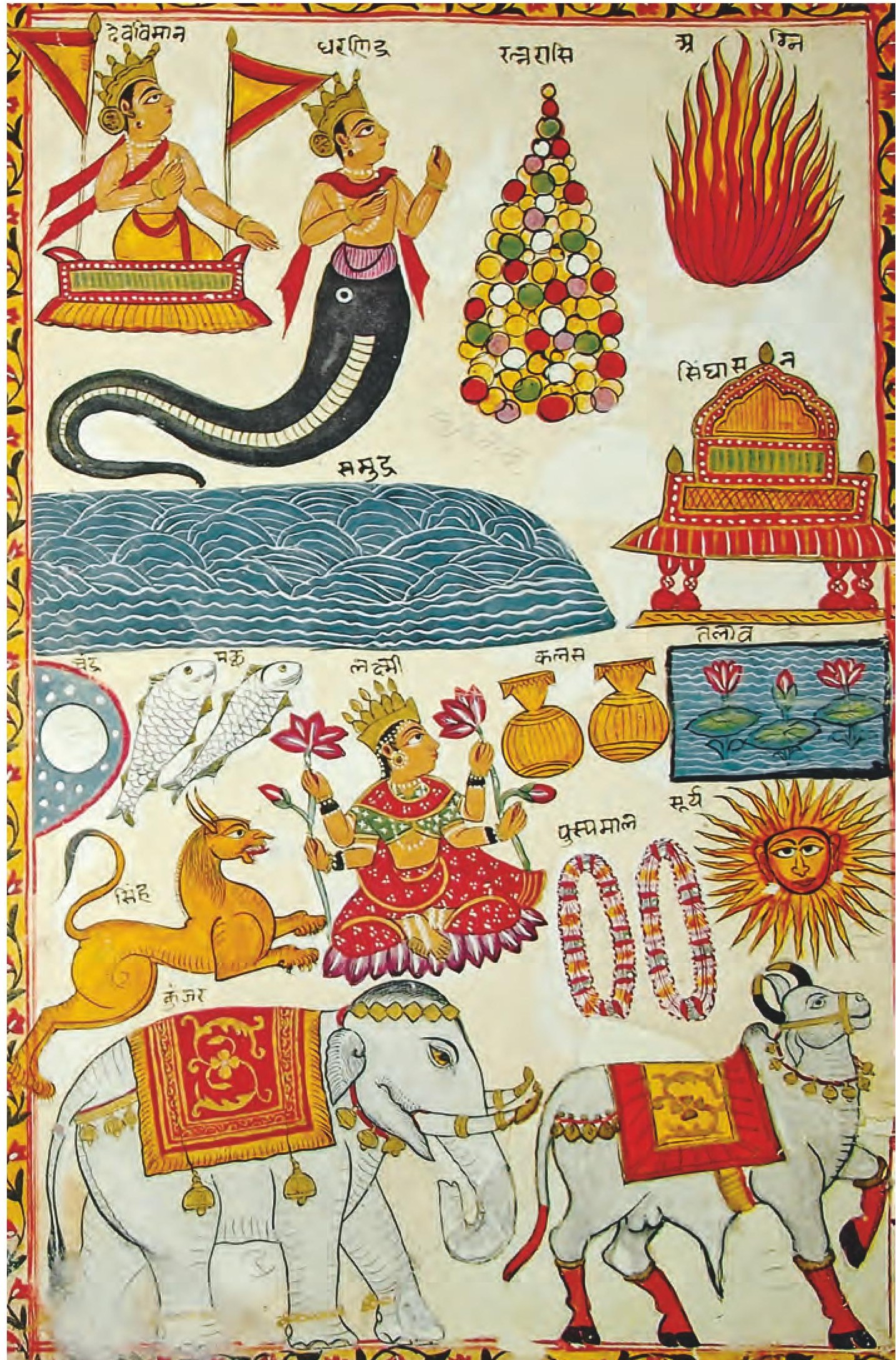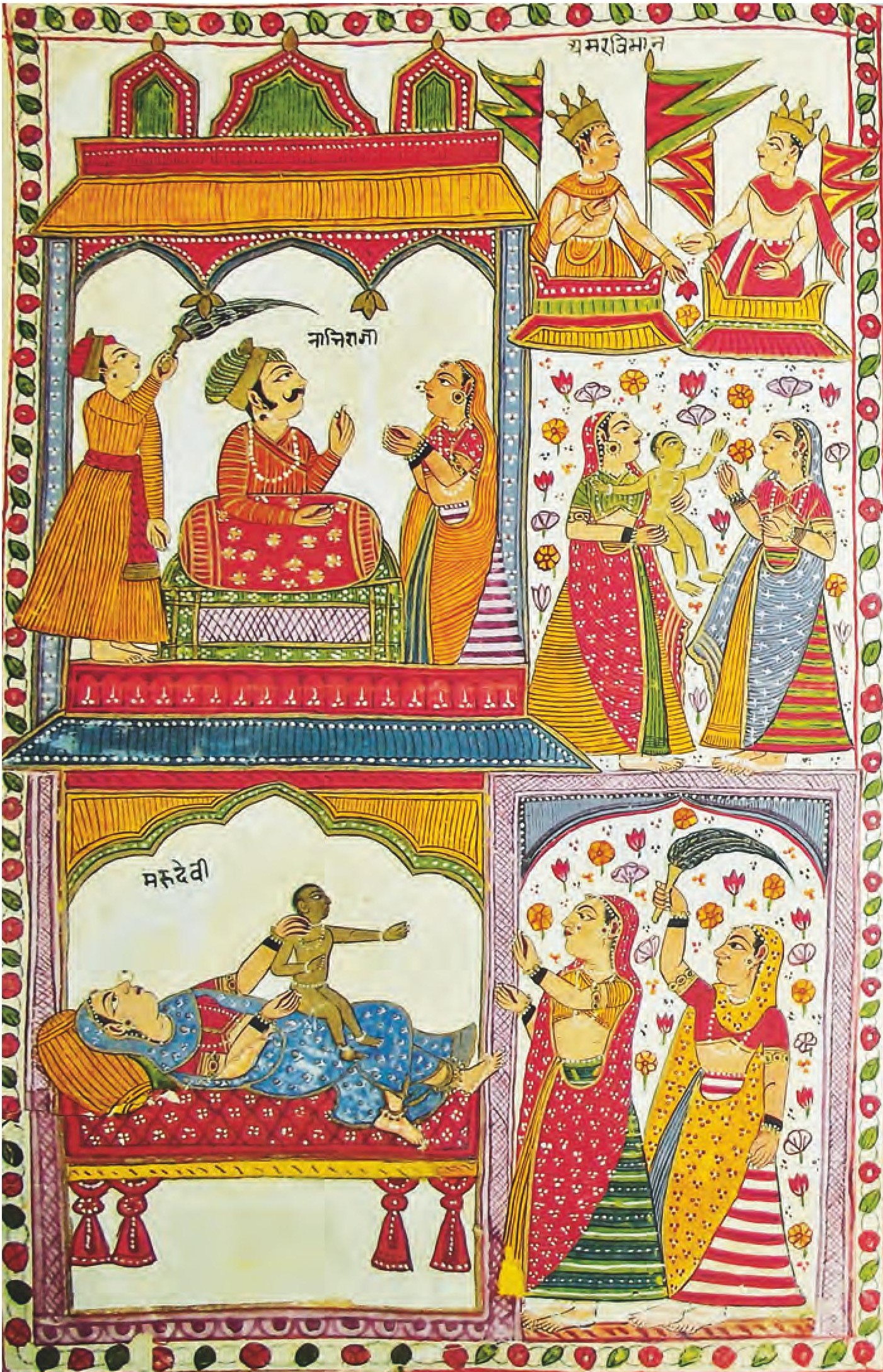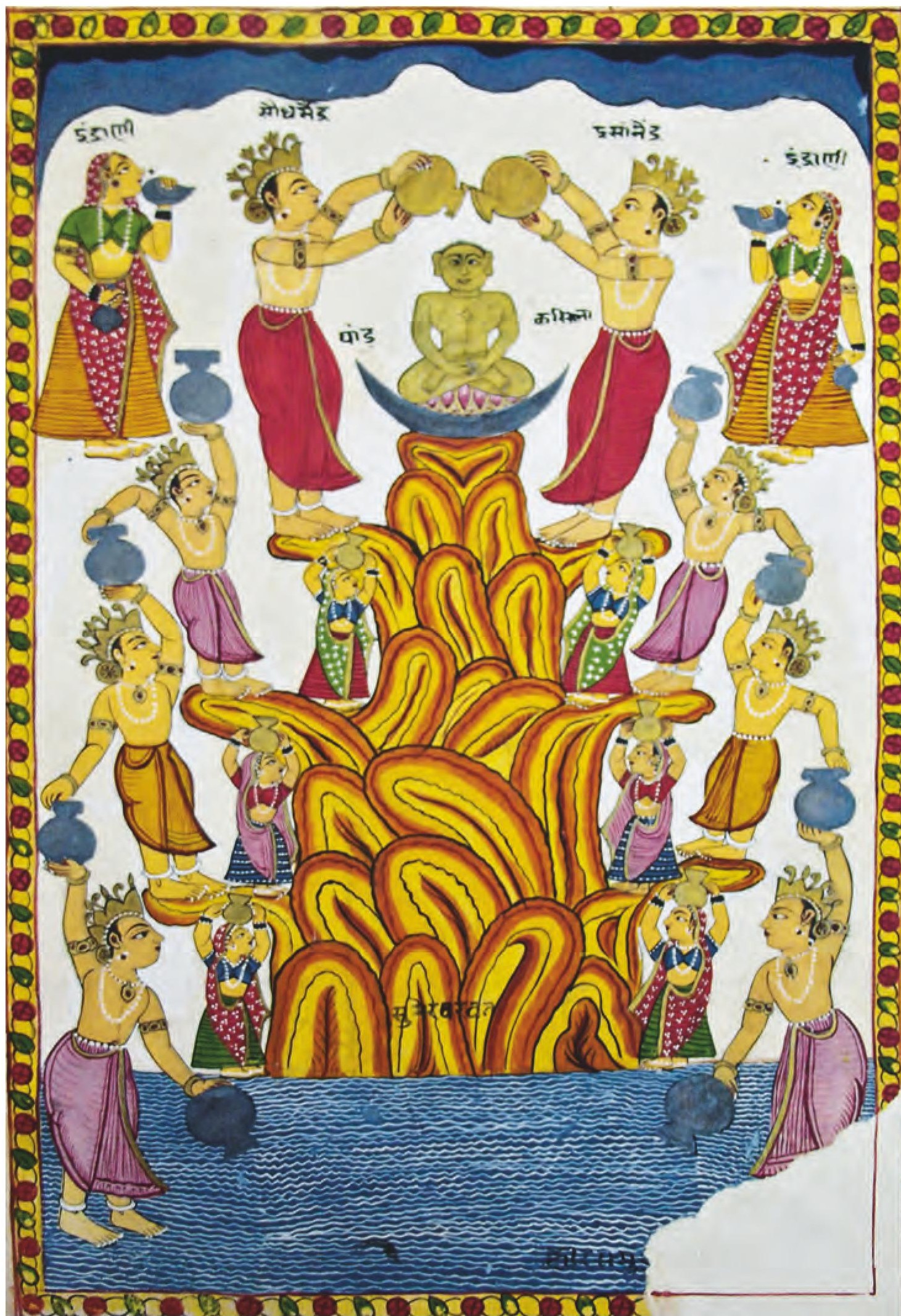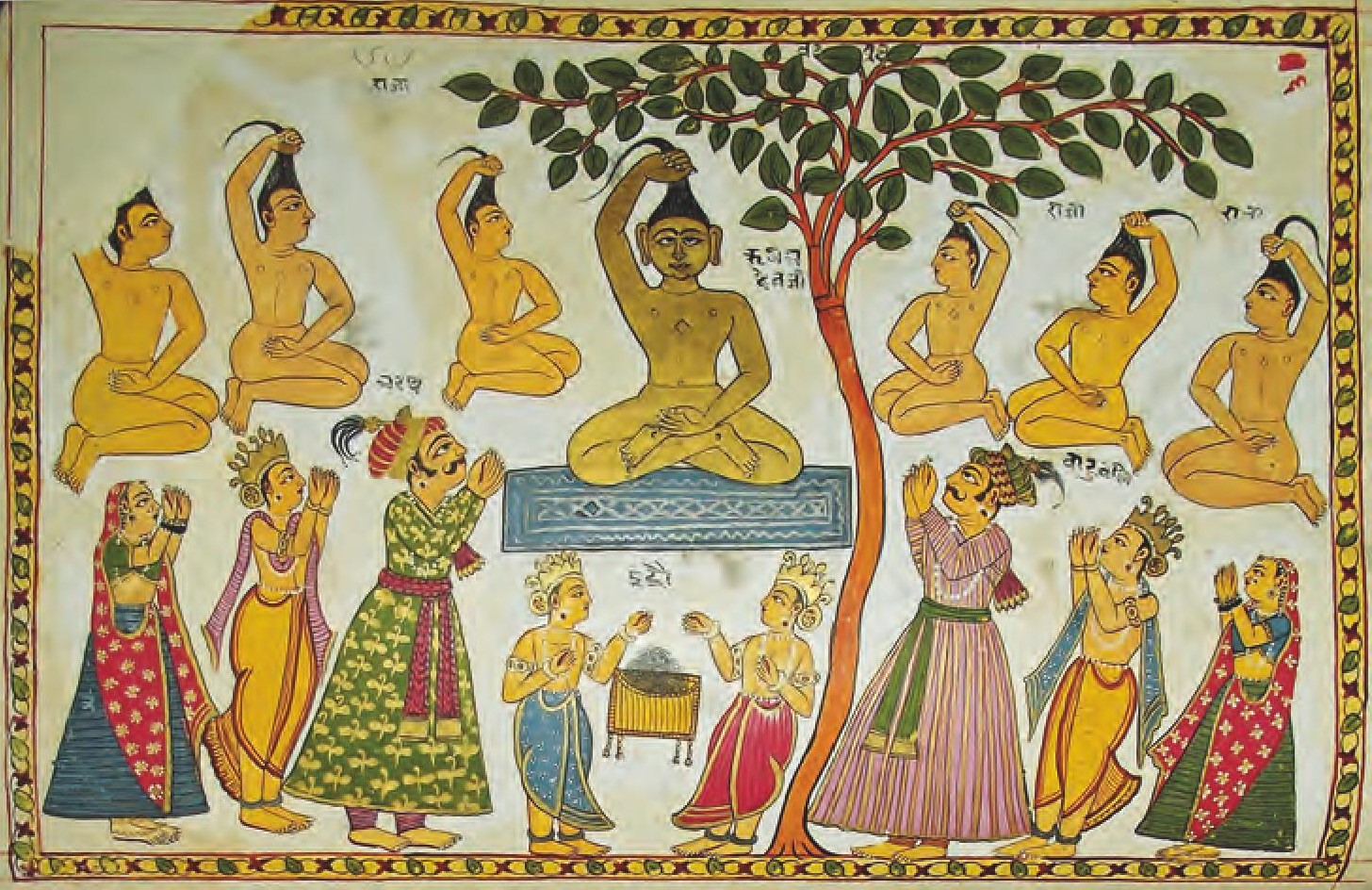Introduction
A private collection in Jaipur has preserved an illustrated Digambara manuscript entitled Bhūpālacauvīsīkāvyabhāṣārtha (‘Meaning of the Sanskrit poem Twentyfour [hymns] by Bhūpāla in vernacular language’), which includes the full text and a commentary on Bhūpālacaturviṃśatikā (‘Twenty-four [hymns] by Bhūpāla’).
Bhūpālacaturviṃśatikā[1], which is also known as Bhūpālapacisī[2], is a wellknown Sanskrit stotra praising the twenty-four Tīrthaṃkaras, which is popular among both Śvetāmbaras and Digambaras. Mostly composed in Sanskrit, the commentary includes some intermediate sentences in Gujarati which relate to the title of the work: The word kāvya, in this context, means ‘poem in Sanskrit’ while bhāṣa means ‘vernacular language’, meaning Gujarati.
The manuscript was made in V.S. 1887/CE 1830 and includes 38 mostly full-paged illustrations. The text has been written in golden, black and red ink. Each section starts with a verse of Bhūpālacaturviṃśatikā written in golden ink, followed by the related explanatory remarks written in black ink with red hyphens (daṇḍa). The title as well as some intermediate sentences and passages are executed in red ink too. The place of origin of the manuscript is unknown, but the miniature paintings’ style and iconography are similar to those of a Bhaktāmarastotra manuscript, presumably from Sirohi[3]. It can almost certainly be assumed that it originated in the Rajasthan region.
The Five Auspicious Events In The Illuminations
The illustrations depict biographical scenes of the twenty-four Tīrthaṃkaras. They start with Ṛṣabha, whose life is narrated in more detail in the paintings as compared to the depictions of the lives of his successors, where each illustration shows similar scenery that includes an enthroned Jina surrounded by emblematic depictions, worshippers etc. In this paper, only the first eight illustrations relating to the fve auspicious events (kalyāṇa)[4] in the life of Ṛṣabha are briefly treated[5].

Plate 7.1 Royal couple and sleeping Marudevī.
In Plate 7.1 (in combination with Plate 7.2), the frst of the fve welfare-producing events (kalyāṇa) in the life of the future Jina are depicted, that is to say the descending of Ṛṣabha into his mother’s womb. The night-time scenery shows the court of king Nābhirājā and queen Marudevī[6]. In the upper section of a twostoreyed palatial building, reclining on bolsters, king Nābhirājā and a woman, probably Marudevī, are sitting opposite each other while talking. The royal couple is accompanied by two pairs of female attendants, standing behind them in the lateral part of the pavilion. One of the handmaidens, standing nearest to the king, holds a peacock-tail whisk (morchal), while another handmaiden behind the queen has a fly-whisk in her hand. Their companions have a jug and a container probably flled with refreshments or betel. The peacocks on the roof-top symbolise the upcoming monsoon, emphasising the atmosphere of love and intimacy between the royal couple. On the ground floor, also reclining against a bolster while being half asleep, queen Marudevī rests on a couch. She is dreaming the sixteen auspicious dreams which, according to the Digambara tradition, are seen by the mother of a future Tīrthaṃkara during her pregnancy. A handmaiden massages the queen’s feet while two couples comprising female attendants are standing on both sides of the couch, holding fly-whisks, a container with refreshment or betel and the bud of a blue lotus (utpala). On the roof-top two peacocks are fanning out their tails.

Plate 7.2 The sixteen auspicious dreams.
The scene continues in Plate 7.2 where the sixteen auspicious dreams of queen Marudevī are illustrated. Beginning at the lower left corner, the objects symbolising the dreams are arranged in fve rows from the bottom to the top of the miniature; most of the dream icons are marked with Devanagarī inscriptions. In the bottom row, the list of dreams begins with an elephant and a white bull. In the second row, a lion, the goddess Lakṣmī, two garlands of flowers and the sun are depicted, followed by the moon, a pair of fish, two golden pitchers and a lake with lotus flowers in the third row. The row above contains an ocean and a lion throne. The topmost row has a celestial palace, the serpent deity Dharaṇendra instead of the usual palace of serpent deities, a heap of jewels and a fre without smoke.

Plate 7.3 Ṛṣabha's birth and the presentation of the infant to the gods.
Plate 7.3 illustrates the second auspicious event in Ṛṣabha’s life, that is to say the birth and the related joy and happiness of the royal court. The two storeys of the pavilion divide the scenery into two registers. In the lower register, queen Marudevī is depicted, lying on her couch with the newborn prince on her thigh. Ṛṣabha, who is of golden colour and adorned with jewellery, reaches out his left arm for a court lady who approaches on the right, attended by a maid with a fly-whisk in her hand, to relieve the infant from his mother. Attended by another woman, the same court lady is depicted in the upper register where she presents the future Tīrthaṃkara to the gods who throw flowers from their flagged celestial vehicles (vimāna) down to the infant. On the left, leaning against a cushion, king Nābhirājā is depicted listening to the court lady, while an attendant fans fresh air with a fly-whisk behind him. The narration probably goes that king Nābhirājā instructed a court lady to bring the infant to the gods who arrived at the court to do obeisance to the future Tīrthaṃkara.

Plate 7.4 The gods convey Ṛṣabha to Mount Meru
The scene depicted in Plate 7.4 is related to the lustration of the Jina, which is treated as the third auspicious event in this manuscript and is illustrated in Plate 7.5. The depicted motif is based on a narrative in the Ādipurāṇa[7]: Indra and his consort Indrāṇī have descended from heaven to convey the newborn infant to Mount Meru, where the lustration of the future Tīrthaṃkara occurred. Indrāṇī, who took the child from his parent’s palace and brought it to Indra’s procession, is riding with the child on her lap on the white elephant Airāvata, attended by two divine companions, one holding an umbrella while the other is directing the elephant. Airāvata is depicted with lotuses and a kalaśa in his fve trunks, surrounded by other gods and goddesses who stand on lotus flowers and play diverse musical instruments, for example, bells, a conch and fanfares.

Plate 7.5 Ṛṣabha’s lustration
In Plate 7.5, the ceremony of Ṛṣabha’s lustration is depicted. The child is sitting on the top of a rock formation symbolising Mount Meru[8]. A lotus flower and a crescent shape comprise his seat. The Indras of Saudharma and Īśāna heavens, positioned on ledges on each side of the future Tīrthaṃkara perform the lustration ceremony (abhiṣeka)[9] while additional celestials, standing on another ledge in a row on top of each other fll water from the ocean beneath the mountain and hand it over. The gods are attended by a number of female deities holding vessels on their heads. In the upper corners, beneath the waved horizon, two Indrāṇīs are depicted on the left and right of their consorts[10]. The Bhaktāmarastotra manuscript mentioned above also includes an illustration of the lustration of a Jina, which is similar in style and iconography to the discussed miniature[11]. However, instead of their consorts, the two Indras are attended by angelic musicians. An additional divine figure is depicted at the foot of Mount Meru. Furthermore, in this miniature the Jina is depicted not as a child but as an adult siddha, sitting on a lotus with a crescent beneath.
The crescent, symbolising Īṣatprāgbhārā or the siddhaloka, is a well-known icon, which marks the liberated Jina already in medieval miniatures. The lotus flower as the Jina’s seat is equally known from bronze and stone sculptures and is a characteristic feature of a divine cult figure. The text sources of both Digambara and Śvetāmbara mention the lustration of a Jina only in conjunction with the lives of Ṛṣabha, Nemi, Pārśva and Mahāvīra, where it must occur soon after their birth. In the discussed manuscript illustration, Ṛṣabha is depicted as a child, while the crescent and lotus seat refer to the liberated Tīrthaṃkara. Thus, we may suppose that the motif of final liberation, which usually forms the ffth auspicious event in the Jina’s life, has been merged in the present manuscript with the motif of lustration. Compared to the related text sources, where lustration is performed with the child, the depiction shows a variant of abhiṣeka, which means “worshipping the siddha”. Hence, concerning the narrative context, the illustration of the adult Jina contradicts the preceding depiction of the transportation of the infant.

Plate 7.6 Ṛṣabha renounces the world.
The fourth auspicious event in the life of Ṛṣabha, that is to say initiation and renunciation of the world, is illustrated in Plates 7.6 and 7.7. In Plate 7.6, Ṛṣabha is positioned in the centre, sitting crossed-legged on a silver-grey carpet beneath a banyan tree, plucking out his hair. According to the Ādipurāṇa, four thousand princes followed Ṛṣabha when he renounced the world. The miniature shows six princes instead, denoted as ‘rājā’ in the inscription, flanking Ṛṣabha while plucking out their hair with the same gesture, while two Indras receive Ṛṣabhas hair and put it into a container[12]. Next to the Indras stand Bharata and Bāhubali with a gesture of devotion, attended by male deities wearing a crown and female celestials.

Plate 7.7 The gods attending Ṛṣabha’s initiation
The scenery continues in Plate 7.7, which is divided into an upper and a lower register. In the upper register a palanquin is depicted, attended by four celestial porters, while in the lower register a group of crowned gods in different positions are seen worshipping Ṛṣabha during a dīkṣā ceremony.

Plate 7.8 Ṛṣabha’s frst sermon in the samavasaraṇa.
In Plate 7.8, the fifth welfare-producing event is illustrated, that is to say the attainment of omniscience, which is symbolised by the depiction of the first sermon. Ṛṣabha is sitting on a throne to the east of the samavasaraṇa, which has been erected by the gods for his preaching after he attained omniscience (kevalajñāna). The three walls of the building, which are made of jewels, gold and silver, are painted in silver, golden and red colour to distinguish the mentioned materials. 12 According to the Ādipurāṇa, the hair was received by only one Indra, who preserved the hair in a casket, which he cast into the ocean of milk.The aśoka tree, which is actually erected in the centre of the samavasaraṇa, is depicted on its left side, bowing its crown above the Jina in devotion. Ṛṣabha is protected by an umbrella (chattra) above his head and is flanked by two Indras bearing fly-whisks. In front of the throne his cihna, a bull, is positioned. To indicate the peaceful atmosphere, which is generated by the universal assembly on the occasion of the frst sermon of a Jina, different hostile animals are depicted around the samavasaraṇa in peaceableness. Beneath the samavasaraṇa, Bhupāla, the author of the Bhūpālacaturviṃśatikā is depicted, standing in a devotional gesture in front of his teacher Vinayacandra. Vinayacandra is depicted with a broom, sitting on a throne with a sthāpanā and a pitcher. The whole scenery is framed by two slim flagged towers on each border of the miniature. The illustration of the frst sermon, preached from the samavasaraṇa, marks the end of the frst sequence of miniatures depicting the fve auspicious events of Ṛṣabha’s life.
Conclusion
The illustrated Bhūpālacauvīsīkāvyabhāṣārtha manuscript discussed in this chapter is of particular interest not only for the illustrations but also for its text, which seems to be unpublished and needs a further investigation by comparing with related manuscripts. According to H. D. Velankar (1944: 298) there is a commentary (ṭīkā) on a Bhūpālastotra, written by Aśādhara, which probably relates to a commentary on the Bhūpālacaturviṃśatistotra by the same author. Presumably, the only known copy of this commentary, which was composed by Aśādhara for his pupil Vinayacandra (Kasliwal 1967: 269), has been preserved in the library (bhaṇḍāra) of a Jain temple at Pāṭodī (Rajasthan). As mentioned, above, Vinayacandra is depicted on the discussed miniatures.
Since this paper includes only a short presentation of eight miniature paintings of the manuscript, a detailed discussion of the complete set of illustrations as well as an edition of the text of the commentary is intended to be published in the future.
Photo Credits
The author thanks Shri Devki Narayan Sarraf for the photos of the manuscript and the permission to reproduce them.
Acknowledgements
The author thanks Nalini Balbir and Adalbert J. Gail for helpful information.
Bibliography
Granoff, Phyllis, 2010, “Illustrating the Bhaktāmarastotra”. In: Nalini Balbir (ed.), Svasti: Essays in Honour of Prof. Hampa Nāgarājaiah for his 75th Birthday. K.S. Muddappa Smaraka Trust, Krishnapuradoddi, pp. 110–117.
Kasliwal, Kastoor Chand, 1967, Jaina Grantha Bhanḍārs in Rājasthān. Mahavir Bhavan, Jaipur. Pal, Pratapaditya, 1994, The Peaceful Liberators: Jain Art from India, Los Angeles County Museum of Art, Los Angeles.
Paṇdit Durgāprasād & Kāśīnāth Pāṇdurang Parab (eds.), 1890, “Bhūpālakavipraṇītā Jinacaturviṃśatikā”. In: Kāvyamālā, Part VII, Nirṇaya-Sāgara Press, Bombay, pp. 26–30.
Velankar, Hari Dāmodar, 1944, Jinaratnakosa: An alphabetical register of Jain works and authors. Bhandarkar Oriental Research Institute, Poona.
 Dr. Patrick Krueger
Dr. Patrick Krueger